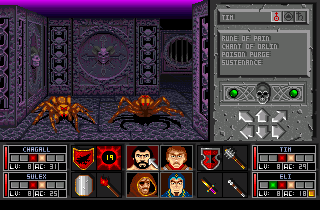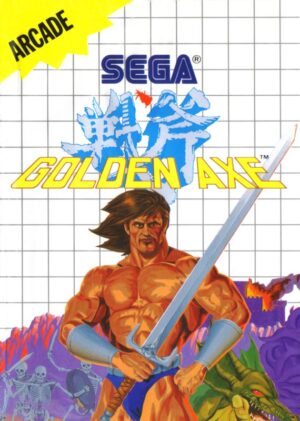Retro Replay Review
Gameplay
Black Crypt places you directly in the heart of a sprawling, multi-level dungeon, challenging you to guide a party of four adventurers through winding corridors, hidden traps, and deadly monsters. The first-person perspective immerses you in each dark chamber, while the tight, grid-based movement system encourages careful planning and tactical positioning. Combat is real-time yet pausible, letting you balance the thrill of fast-paced action with the patience required to coordinate spells, melee strikes, and defensive maneuvers among your party members.
(HEY YOU!! We hope you enjoy! We try not to run ads. So basically, this is a very expensive hobby running this site. Please consider joining us for updates, forums, and more. Network w/ us to make some cash or friends while retro gaming, and you can win some free retro games for posting. Okay, carry on 👍)
Character development is robust, with each adventurer representing a distinct archetype—warrior, cleric, mage, and thief—and leveling up as they accrue experience from vanquishing foes and solving puzzles. Inventory management plays a crucial role, as space is limited and every item, from healing potions to enchanted weapons, must be chosen with foresight. Puzzle-solving elements, such as pressure plates, lever sequences, and teleportation spheres, break up combat encounters and encourage exploration of every nook and cranny in search of secret passages and hidden treasures.
The difficulty curve in Black Crypt is both rewarding and unforgiving. Early attempts can prove lethal if you rush headlong into combat without mapping the dungeon or stockpiling necessary supplies. Learning to read subtle audio cues—such as the skittering of giant rats or the distant howl of a banshee—becomes just as important as equipping your best armor. This emphasis on player skill and preparation makes each triumph over a challenging guardian or navigational puzzle feel deeply satisfying.
Graphics
Originally released in 1992, Black Crypt’s graphics stand as a testament to the capabilities of Amiga hardware at the time, featuring detailed pixel art environments rendered in a moody, limited color palette. Each wall texture, from moss-covered stone to dripping cavern runes, contributes to a palpable sense of dread and wonder. The use of light and shadow enhances immersion, with flickering torches and shimmering magic spells cutting through the darkness in dramatic fashion.
Enemy sprites are impressively animated, showcasing fluid motions from the lumbering gait of trolls to the fluttering wings of skeletal bats. While the resolution may seem modest by today’s standards, the crisp delineation of corridors and floor tiles ensures that navigation never feels muddled. Inventory icons and spell effects pop vividly, making it easy to distinguish between healing elixirs, keys, and cursed artifacts at a glance.
Special effects—such as the swirling vortex of a teleport spell or the burning glow of a fireball—are both functional and aesthetically pleasing. Even the user interface, though minimalistic, feels appropriately integrated into the visual design, with clearly labeled buttons and text boxes that evoke the sensation of peering through an adventurer’s journal. The overall graphical presentation remains charmingly retro, appealing to both nostalgic players and newcomers curious about the roots of 3D dungeon crawlers.
Story
At the heart of Black Crypt’s lore is Estoroth Paingiver, a cleric who once wielded unholy power before being sealed away in the crypt that now bears his name. Twenty-two years of imprisonment have only strengthened his resolve, allowing him to corrupt the land of Astera once again. The narrative premise is simple but effective: you must reunite the four relics that originally bound Estoroth, reassembling them piece by piece as you delve deeper into the crypt’s booby-trapped vaults.
Story beats are delivered sparingly through scrolls, statues, and the occasional NPC encounter in subterranean shrines. While dialogue is minimal, it feels purposeful—each snippet of lore informs your next objective or reveals subtle hints about hidden chambers. This light-handed approach keeps the narrative from distracting the player, instead enriching exploration by rewarding attention to detail and curiosity about the crypt’s history.
Despite its linear quest structure, Black Crypt offers atmospheric world-building. The ambient soundscapes—dripping water, distant whispers, and the echo of your own footsteps—reinforce the feeling that this crypt has lived many lifetimes before you arrived. You’re not simply clearing floors; you’re uncovering the layers of Estoroth’s dark influence, inching ever closer to the final confrontation that promises to decide the fate of Astera.
Overall Experience
Black Crypt remains a landmark title for fans of dungeon-crawling RPGs, combining an immersive first-person interface with deep tactical and puzzle-solving gameplay. Its challenging difficulty and methodical pace cater to players who appreciate careful exploration and strategic resource management. While modern titles often streamline these elements, Black Crypt excels by embracing complexity and rewarding perseverance.
The game’s blend of atmospheric graphics, evocative sound design, and minimalist storytelling creates a cohesive mood of tension and discovery. Even after decades, the crackling of a magic missile or the creak of a closing dungeon door retains its power to send shivers down the spine. For those willing to navigate its labyrinthine halls and rising challenge, Black Crypt delivers a memorable journey—one that feels like the foundation upon which many contemporary dungeon crawlers were built.
If you’re a newcomer to early ’90s RPGs, Black Crypt offers a valuable glimpse into the genre’s evolution, presenting mechanics and aesthetics that influenced countless successors. For veterans, it stands as a nostalgic return to a time when every step in a dungeon carried genuine risk and reward. Either way, venturing into Black Crypt’s depths is an adventure worth undertaking for anyone seeking a classic dungeon RPG experience.
 Retro Replay Retro Replay gaming reviews, news, emulation, geek stuff and more!
Retro Replay Retro Replay gaming reviews, news, emulation, geek stuff and more!









Reviews
There are no reviews yet.